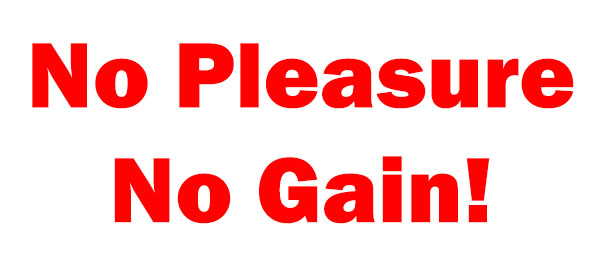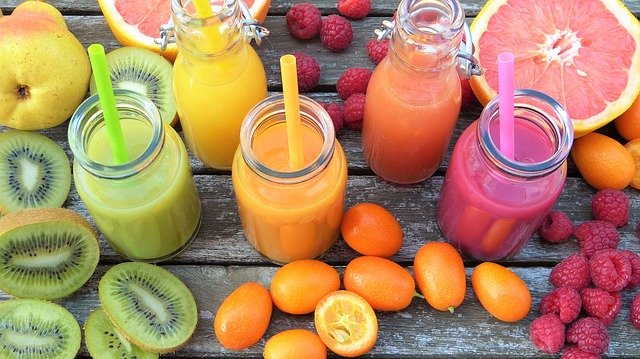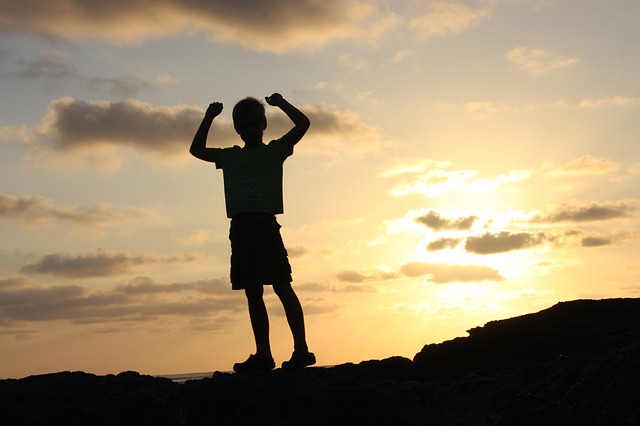
I think we’ve all heard the maxim “no pain, no gain” applied to exercise and the pursuit of health and fitness, and I’m guessing that it won’t surprise you to discover that this runs counter to underlying principles of qigong practice. In this article I will suggest another maxim to substitute for this currently well known one, and explore the benefits of taking this alternative approach, not only for physical training, but for many other areas of our lives as well. I believe that adopting this alternative maxim can be a powerful tool for achieving health, fitness, success, and fulfilment, and by exploring the benefits of this approach fully, I hope that many people will adopt it, and maybe – just maybe, one day it will displace the older “no pain, no gain” saying. But before I do that, I will explore some of the benefits of the “no pain, no gain” approach to understand why it has had such enduring popularity, as well as looking at some of the potential problems that arise with this approach.
Facing the challenges of life
Some things in life can be difficult, awkward, uncomfortable, or challenging. If we avoid addressing these obstacles in our lives, it can prevent us from making progress towards things that would bring us success and satisfaction. Our attempts to avoid these discomforts may even divert us off into directions that are undesirable and quite far from where we would like to go and what we would like to achieve. Part of the benefit of adopting a “no pain, no gain” approach to life, is that this mindset encourages us to address the challenges that arise directly and not be put off by the difficulty, discomfort, and even pain that may be involved in working towards what we truly desire.
Maximum effort
Another potential benefit of this approach relates to the level of effort we put into our pursuits. Pain is a natural warning sign that our body is approaching, at, or even past our physical limits of exertion. You can think of pain a bit like a warning light on your dashboard, letting you know that you have reached your maximum effort. Without putting in sufficient focused effort we may not make progress towards our goals, but if you exert yourself to the point of pain – you will know you have given it your all, and so the thinking goes, you will therefore be more likely to move towards, and succeed in achieving your goals.
Problems arising from the “no pain, no gain” mentality
So there are clearly some situations where someone may achieve good results with a “no pain, no gain” attitude. But there are also many potential problems that can arise from this attitude in both the short and the long term, and in my opinion these outweigh the potential benefits. Even more importantly, as we will see later, with a more nuanced approach we can achieve all those same benefits and more, without the potential problems arising from the “no pain, no gain” mentality.
There’s a reason for the warning signs…
There’s a reason why we have a natural instinct to move away from and avoid pain. Pain is our bodies way of letting us know that we may be either on the verge of doing harm to our body, or that it has already been damaged and we now need to give it extra attention to protect it and allow it to heal. While there may be no serious consequences arising from minor pain, if we ignore or override these signals we can make ourselves prone to damage that far from helping ourselves to achieve our aims may actually prevent us from reaching them. When we push our level of exertion to the point of experiencing pain, we are already right on the limit of our capacity. At this point we don’t have any extra leeway for something unexpected happening, which could quickly tip us past the point of productive effort, and into injury which will then slow down our progress.
Internal resistance
Dancing too close to this fine line too often will inevitably lead to crossing it at least occasionally, and our body and unconscious mind learns from these experiences. They start to associate our efforts in pursuing our goals with pain and harm. Because of this, over time we will build up more and more internal resistance to our efforts. Our body knows that it can’t trust our conscious mind to pay attention to the warning signs it gives us, so our unconscious mind intervenes to find other ways to prevent us from damaging ourselves, and we may find that it gets harder and harder for us to continue with our efforts, even when there is nothing obvious externally preventing us from them.
Pain can become a proxy for actual success
When we embrace this “no pain, no gain” mentality too fully or for too long, due to the conscious association between pain and progress, we may unconsciously start to substitute pain for actual progress as an unconscious marker of success. We may begin to seek out pain itself rather than our initial goal. This re-orienting of our internal directives can be deeply harmful to us, leading to a variety of self destructive or limiting behaviours which harm us rather than helping us to progress.
This principle applies not just to our physical pursuits but to other areas of our life as well. Without knowing it, if we create the wrong associations, we can find ourselves unconsciously seeking conflict so that there is something to ‘resolve’ if we have associated the uncomfortable aspects of conflict resolution with success and progress. This keeps us trapped in a continuous cycle of new conflicts and issues to address – rather than seeing how we can truly move forwards with ease. I’m sure each we some reflection each of us can identify times in our lives when we have found ourselves reinforcing these types of patterns, or people we know who seem to be perpetually stuck in these cycles.
An Alternative
But there is an alternative approach that we can take, that allows us to overcome some of the shortcomings of the “no pain, no gain” paradigm. We can flip this saying completely on its head and start to orient ourselves towards a “no pleasure, no gain” attitude.
For many of us even starting to think about this concept may bring up some hesitation and caution, because it is so fundamentally different from some of the deep underlying beliefs and attitudes that may have been pervasive throughout our life. Even if we haven’t held those view consciously, they are often there – quite deeply entrenched in our unconscious model of the world. A thorough understanding of how to apply the “no pleasure, no gain” paradigm can help to overcome any caution around adopting it and allow you to embrace it fully.
What really feels good?
To start with, it is important to understand that adopting a “no pleasure, no gain” approach to life does not mean an abandonment of work and effort and decent into hedonism and debauchery. To apply this paradigm well, we need to be able to tune in to what really and truly feels good and brings us pleasure.
Health feels good!
A healthy body and a healthy mind feel good! Good postural alignment, muscles that function well, good blood flow, balanced nervous function, and healthy hormone levels all contribute to our overall health and wellbeing, and all lead to sensations of pleasure! With a healthy body even the most simple activity can become pleasurable as part of the joy of living! So part of successfully applying a “no pleasure, no gain” approach includes adopting a longer term view and recognizing the overall pleasure that we achieve rather than just short momentary bursts of pleasure.
Many of the things that give too intense a sensation of pleasure in the short term, ultimately lead to a huge decline of health, wellbeing, and pleasure in the longer term. So having a focus on the overall pleasure that we experience in life will help us to avoid some of those intense short term pleasure pitfalls that can ultimately lead to decline, pain, discomfort and unhappiness.
Retuning our senses
This may require some degree of retuning our senses and what we actually interpret as pleasurable. One example of this that is easy to experiment with is consumption of refined sugar (and our diet plays a big role in the overall quality of our energy). There are good reasons why our bodies are inclined to seek out sugar, and why we therefore tend to find consumption of it pleasurable. But because a lot of the sugar we consume in our modern environment is highly refined, it can have an overpowering effect on our senses, and this tendency to seek out sweetness, which can be very beneficial in a natural environment, can end up being harmful to us and leading to an excessive intake of sugar and overall unbalanced nutrient intake with all of the attendant health and wellbeing issues that can follow.
To retune ourselves, we sometimes need to take a complete break from a particular stimulus to allow our senses to recalibrate. To do this with sugar, try not consuming any refined sugar for a period of time to allow not just your sense of taste to adjust, but also the whole chain of hormonal responses that come from eating these concentrated refined foods to balance out as well. Two weeks without any refined sugar is usually long enough to have a very significant and noticeable effect. It is a simple thing to do, but can also be quite challenging. You will notice that I have underlined the word any for a third time now, and this really is important to really experience the benefit of doing this. You need to read the labels of any premade or packaged foods to check whether there are refined sugars in them, as consuming even a little bit stops you from having a complete break from this stimulus, and can keep you in your habitual pattern of response and perception.
When you give it a try, you will quickly realize just how much refined sugar there is within so many different foods in our modern environment. To avoid them all can be a bit of a challenge and requires careful and diligent reading of labels, or sometimes even just preparing foods yourself during that period of time. If you prepare your own food using only natural and whole ingredients, you will know exactly what is in your food, and there won’t be any refined sugar that creeps in through using a food product that you never imagined would contain any.
Many people find that on completion of two weeks with no refined sugar, their whole experience of consuming it is changed. Instead of enjoying and seeking out refined sugar, they actually find it is now distasteful to them. They no longer interpret the intense hormonal response to this highly refined food as feeling ‘good’, and they actually try to avoid foods with refined sugar in them.
A big part of this is because now other foods start to taste much better to them. You can think of the intense stimulation of refined sugar as being like one REALLY LOUD instrument in an orchestra. You might like the sound that comes from that particular instrument, but drowns out all the other sounds (flavours) so you can’t enjoy them fully. When you quiet down the sound (flavour) from this one instrument, you can then hear all the subtle details of the other instruments as they play a symphony – creating a much richer experience. By eliminating refined sugar, you start to notice all the other flavours in more detail, including the natural sweetness of many foods that you might not have otherwise noticed before because they were being drowned out. This opens the way for a much richer experience of food in general, and the finer details of your response to it.
After this experiment, if you’re not careful about how you continue to eat, it is easy to slip back into habits of refined sugar consumption – because its presence is so pervasive in our modern food supply. Even if you don’t think you are going to eat much of it, little by little it slips in within different food products, and your sensitivity and response to it is dulled and you return almost to where you started – except now you have a contrast. Now you know what it feels like to not be consuming refined sugar. You can remember the way you sense of taste and response to other foods was heightened, and you can also remember the difference in your overall all energy and having a sense of freshness and clarity without refined sugar, compared to the general sense of lethargy and malaise that accompanies excessive consumption. You can then that let you act as deep guidance for you in your orientation towards what brings you true and deep pleasure rather than what actually brings you reduced pleasure in the bigger picture.
This same principle applies to other things and areas of our lives as well – not just sugar. Taking a complete break from a dysfunctional relationship, situation, or something else in your life, can give you a chance to break the habit and recalibrate your senses. Leading to a clearer and better perception of it, and hopefully an opportunity to bring it back into a balanced position within your life – leading to more sustainable pleasure in the longer term.
Growth feels good!
But what about those hard things that we need to deal with in life? Adopting a “no pleasure, no gain” approach to life does not mean avoiding any difficult thing that arises.
Have you ever heard of the term “good pain”? It is often used in reference to stretching or sometimes massage, when someone talks about how an experience hurt, but it was actually “good pain” rather than bad pain. Well… here’s a newsflash for you… “good pain” is not actually pain – its pleasure!
What we choose to call the different physical sensations we experience comes down largely to how we interpret them. Two people can interpret the exact same physical experience in very different ways. For one person driving really fast in a sports car is enjoyable and exhilarating, for another person it is terrifying! The difference in perception is due to difference in expectations derived from previous experiences, and the big difference between these two situations is confidence! If for whatever reason the person in the car is not confident of staying safe while driving at speed – they will interpret the same experience, and the physiological responses their body makes to attempt to adapt to the situation they are in – things like increased secretion of adrenalin, dilation of the pupils in the eyes, increased heart rate to send blood to the muscles etc – as terrifying. While if the person has confidence that they will stay safe even while driving fast – those same physiological responses and their experience of the whole situation can be interpreted as exciting and even fun.
When they have this more confident feeling about the situation, they are more likely to retain a better level of calm and focus. They will notice more details of the condition of the road and how the car is responding – and this will help them to develop their driving skills further so their driving actually becomes safer. While if the person becomes overwhelmed by the experience and it becomes scary for them – they are more likely to overreact and respond badly to the driving conditions. They are unlikely to remember or learn useful details from their experience, and without carefully considered training to help them to break the pattern, this can make them more likely to continue to overreact in the future, making their driving even less safe.
It is true that growth is stimulated by exploring our limits so that we can develop into previously unexplored territory. If we don’t listen to our body, and push those limits too far we can end up experiencing “bad pain” from the resulting damage. These experiences can lead us on either a conscious or unconscious level to no longer trust our judgement about how far we can go within our limits safely, and our body and mind may start to put in more levels of alarm and interpret different sensations that are not actually harmful to us as “pain”. On the other hand if we do listen to our bodies, then the process of approaching our limits can become very enjoyable and stimulating. We can then interpret those sensations we experience as “good pain” or just pleasure, because on some level we know that they are actually indications of growth and progress – good things that we want more of and should be oriented towards. We have confidence that we can do this with safety, and so this allows us to relax, enjoy, and get the full benefit from our experiences.
As we continue to work with a “no pleasure, no gain” orientation, we become better and better and distinguishing the line between positive growth and development, and going to far and causing damage and harm. We can spend more time in that growth zone, knowing that we won’t cross the line, leading to more and more long term pleasure and satisfaction.
Success feels good!
And finally success feels good! When we orient ourselves towards pleasure, we orient ourselves towards success. We don’t seek out struggle, difficulty, or pain just for the sake of it, or from a miscalibrated association between these experiences and progress. We probably all know someone, or perhaps that person is ourselves, who no matter what good thing happens in life, or what they achieve, can never seem to be truly happy with it. Often these people are so calibrated towards the difficulty of achieving something that even when success arrives they cannot fully recognize or enjoy it. Even in the very moment of success they are looking for the next obstacle or struggle to deal with.
When we orient ourselves towards pleasure, we are able to fully embrace and enjoy the experiences of life. We are also able to create even more success in our lives, because once we have experienced some success – we then immediately go looking for more success rather than looking for problems. Where our mind goes, our energy tends to follow, so if we look for problems we have a higher chance of finding them! But if we look for success and the pleasure that brings, we have a greater chance of finding it more easily without having to deal with problems that we don’t need to.
This orientation helps us to enjoy each step along the way of our journey through life as we find pleasure not just in the destination, but also in the process of getting there.
How can qigong help us to successfully adopt a “no pleasure, no gain” orientation
Qigong provides us with some great tools as we seek to bring success and pleasure into our lives. Within qigong we focus on subtle sensations within our body to identify how our energy is flowing within us. We come to better understand the relationship between things. Not just between parts of our body, but also between our mind, body, emotions, and even our external environment. We seek to bring all of these into harmony so that our energy can flow more freely within. We truly embody the principle of “no pleasure, no gain” as healthy flowing energy feels REALLY GOOD! Little by little we make adjustments so that we can experience more of the pleasure of this healthy energy flow.
We also learn through experience that when we experience pain – and by that I mean “bad pain”, this causes excess tension and blocks our energy flow – and is not beneficial to us. So we learn to be gentle with ourselves and find ways to move and be that create ease within us, and that allow us to grow and develop safely to our full potential.
As we develop this perception with our physical body, and become more familiar with the connection between our mind and body, this also helps us to understand wider patterns within our lives more fully, and becomes a starting point for doing deep inner work to release patterns that are not serving us, creating pain or conflict in our lives and are holding us back.
If you would like to dive deeper into the healthy energy flow we can develop through qigong practice, Long White Cloud Qigong has an in depth 200 hour qigong instructor certification program starting soon (November 1st) exploring the Small Universe Qigong system. Within the program we will delve into practices that work with all of the primary flows of energy within us. The organ meridians that flow like rivers, the extraordinary meridians that are like the ocean currents circulating our stored energy, and the energy that fills the field around us and moves likes clouds and rain, bringing energy to wherever we need it. Within the program we also work with the foundations of our breathing skill, and a series of powerful qigong meditations to help develop the connection between our mind and body.
The program is focused on helping you to really experience each of these aspects of your energy for yourself, and understand them well enough that you can teach the practices to others. An even if you do not plan to teach – this journey can be a great part of your own personal development understanding yourself and your vital energy.
You can find details of the program here: 200 hour Small Universe Qigong Instructor Certification Program.
If you would like to keep up to date when we post more articles like this one, or have news about courses and programs, your can subscribe to our email newsletter in the box below:











1 Comment. Leave new
I have always said “no pain, no pain!” I still feel that I have had a good workout most of the time after a Qigong session. But I am not hurting or aching. I feel I have moved forward with balance, strength, flexibility, and peace of mind. I may have a little soreness but it’s the good kind not the “get me to a hospital” kind. Good article, John.